I always prefer to learn skills on the first try. But, sometimes, it doesn’t work like that. I may need a second, third, or even fourth attempt. That was my experience with the Thai language. I tried to learn it in 2020, put it on hold for a year and a half, and got back to it at the end of 2022.
When I tell others I started to learn Thai, one of the first things they ask, is: “Why are you learning Thai?”. A legitimate and important question. My short answer is: because I’m a Buddhist 🙂. Having clarity on your reasons for learning a certain language or skill turns out to be vital. And it’s not about having a good answer when others ask. It’s about you knowing why you’re doing it. What makes you want to do it? If we don’t ask ourselves why we learn what we learn, we may end up picking up languages or skills that are not entirely meaningful to us. Skills that are supposedly useful or good for us.

There is a difference between vocational -ie. used for work- and avocational skills -think of hobbies and recreational activities. In this article, I focus on the latter: avocational skills, things we do entirely for fun, enjoyment, and because we freely choose them. I don’t have to learn Thai to perform a current job. I want to learn it because it will give me access to Dhamma talks, books, and conversations with Thai people and other Thai speakers around the world.
Knowing why you study a language is important. And so is knowing when and how you want to study it. Unfortunately, sometimes we forget or don’t know that it’s possible to choose that as well. This is an important thing I learned after my first attempt at Thai learning.
So, I know why I’m learning Thai. But, how am I going to do it? Am I going to learn Thai as I did the first time, or will I try something different?
My First Attempt at Learning Thai
At the end of 2020, I didn’t have any plans of starting to learn Thai. Despite that, there I was, preparing myself to tackle the language. It happened almost by chance. In late 2020 I enrolled in a language learning seminar on a method I wanted to try. My idea was to apply that to recover my rusty and decaying German skills. I studied German between 2012 and 2014. After that, I stopped using the language altogether for more than six years. When I enrolled in this language learning seminar, I didn’t know it was meant to be applied to a foreign language we were learning from scratch. As I was a false beginner in German, the course instructor recommended picking a new language to try the method. The only one that came to my mind and seemed interesting enough was Thai.
I applied the method diligently for three months, studying for about an hour every day. Unfortunately, at the end of the three months, I wasn’t able to do much with the language. Even though I had done my fair share of research on resources, and had put in the extra time to learn the Thai script (I used the books Read Thai in 10 Days, which is excellent), that was not enough. I probably didn’t apply the method well and just kept going through the motions. I progressed through the lessons of the learning resource I had chosen -the first 90 lessons available on Thaipod101.com– with very little or almost nothing to show for it at the end of the three months. The only real thing I could do was recognize the letters and sounds of the Thai script and understand a handful of basic Thai words and phrases. My reading skills overall were just not what I expected for the time investment I had made in the language.

It would be unfair to say the language method I tried was not good, or that the resources I picked were bad. I can’t say either that I was lazy or that I didn’t put in the time, because I put forth effort. What was the problem then? What went wrong here? I think the main issue was my lack of self-assessment and self-evaluation on how I was doing throughout the learning progress. Early in the process, I knew I wasn’t retaining and remembering much. Still, I continued doing the same things over and over. As if, at the end of the three months, I should magically be able to understand the language. I fooled myself into thinking that my efforts and diligence in daily practice should be rewarded. Despite me learning next to nothing for weeks and months on end.
In March 2021, I was officially done with Thai. That’s when I finished the 90 days I was supposed to practice to try this method. Eventually, I decided to put the language on hold. I wasn’t satisfied with my results, but I knew I would try it again sometime in the future. And I knew I would try something different.
One of the reasons I decided to put my Thai on pause was that I wanted to recover my German skills first. I spent all of 2021 and most of 2022 re-learning the language and engaging with German content and native speakers. In May 2022, I decided to prepare myself for a language test: the Goethe-Zertifikat C1. I took and passed the exam in September 2022 🎉😀. Even though in 2022, I was already reading books in German, listening to podcasts, and reading newspapers in the language, I needed to make it official. That’s why I decided to take the exam. Only then I permitted myself to return to my Thai studies.
My Second Attempt at Learning Thai
I started my second attempt at Thai learning on October 1st, 2022. Even before starting, I knew I would use the learning resources of BananaThai. I discovered them as early as December 2020 and kept the name always in my mind. After watching their YouTube videos, listening to their podcast, and taking a deeper look at their website, it was evident to me that the people at BananaThai root for their students and truly want them to succeed 😊. They offer a preliminary free call to recommend which one of their products (and in which order) would be best for each student. I absolutely loved that!

I made my consultation call in September and decided to get the full bundle, which would give me plenty of materials for the first 6-9 months of study. As I got the biggest bundle, I obtained a second consultation call as well (this time with Kru Smuk, the main teacher and founder of the language school). We talked a bit about my first attempt at Thai learning and my language-learning background. She recommended the following learning plan for the first 6 months:
- *Learning the Thai script and how to read sentences (Ultimate Guide to Thai Reading)
- *Learning and practicing pronunciation (Thai Pronunciation Series)
- Practicing reading skills with short stories (Thai Reading Exercises)
- Learning the basics of everyday interactions and easy conversations (Intensive Thai Course)
- Practicing listening with easy dialogues (Thai Listening Exercise)
By the way, full disclaimer: I’m not affiliated with BananaThai 😂. I just happen to like their content, and I’m having a blast with it 😊. Would recommend it anytime!
The roadmap stated above should take around 6 months, starting from scratch. In my case, I already had some experience reading the Thai script (although now I noticed that the first time I wasn’t able to read sentences properly, with good pronunciation and accurate tones). Being a piano player and having experience with singing and pronunciation studies in other languages (mainly American English and German) helped as well. My goal is to complete all the materials stated above by March 31st, 2023 (that is, in six months or less).

For those who are mainly interested in developing conversational fluency in Thai, it’s possible to take other learning paths. For example, many people use romanized text and pronunciation transcriptions as an alternative to the Thai script. That can help you start communicating in the language earlier, although might not be the best long-term plan. In my case, as I want to achieve a very advanced level in the language, I decided to start (again) with the Thai script from the beginning. That’s the general recommendation for those who want to reach a high level. If that’s your case, it’s better to use the Thai script from the get-go. The first few months -ie. learning the Thai script- will be the most difficult, but after that, I can confirm it gets easier and more enjoyable. Having said that, I don’t fool myself: I know this is a very distant language for me (totally unrelated to any other languages I know), and it will still be challenging. But that makes it more interesting and exciting to learn! 🤓
My Daily Thai Learning Routine + Language Log Template
I study Thai for one hour a day, every day. I started on October 1st and have just completed October and November without missing days. To keep it tidy and organized I maintain a language learning log in Google Docs (thanks Luca Lampariello for the inspiration to start logging my practice sessions!). Here you can see my log for the first two months (October and November 2022):
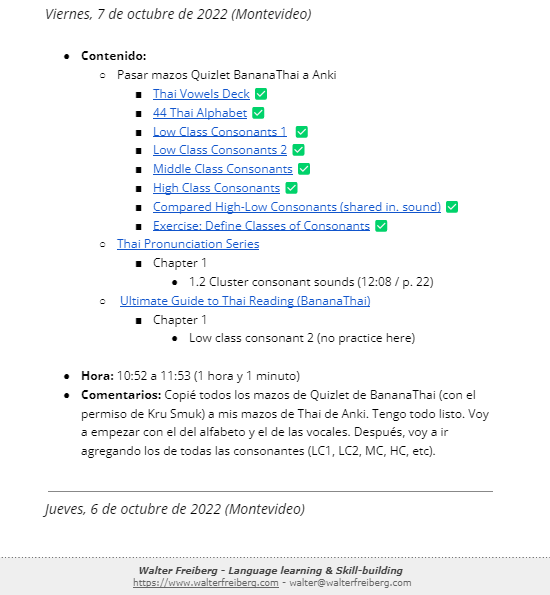
If you’d like to log in your language practice, here’s a Google Docs template I made for you. The link will prompt you to create an editable copy of the document. Just rename it however you like and you’re good to go 😊:

On October, 17 out of 31 days I started my study session before noon. In November, however, I decided to move the study sessions to the afternoon after the first week (only 9 days out of 30, I completed the sessions in the morning). This month I intend to continue doing my Thai study sessions in the afternoon. So far, that seems to be working fine for me.
These are tools and resources I used in the first two months of my Thai studies:
Electronic devices
- Laptop
- to watch the videos and play the audio files of the online courses
- E-ink tablet with stylus
- to read the PDF e-books
- to fill in workbooks
- to practice the Thai script
- take notes
- write translation exercises
Learning resources
- Online courses and e-books
- Ultimate Guide to Thai Reading
- Thai Pronunciation Series
- Thai Reading Exercises
- Dictionaries
- Talking Thai <> English, Dictionary+Phrasebook
- SRS software
- Anki
- 12 mini-decks created with BananaThai contents (239 cards)
- Anki
Other materials
- Music
- Spotify playlist of Thai pop, ballad-style songs
- Printouts
- to practice tone rules anywhere 🤓
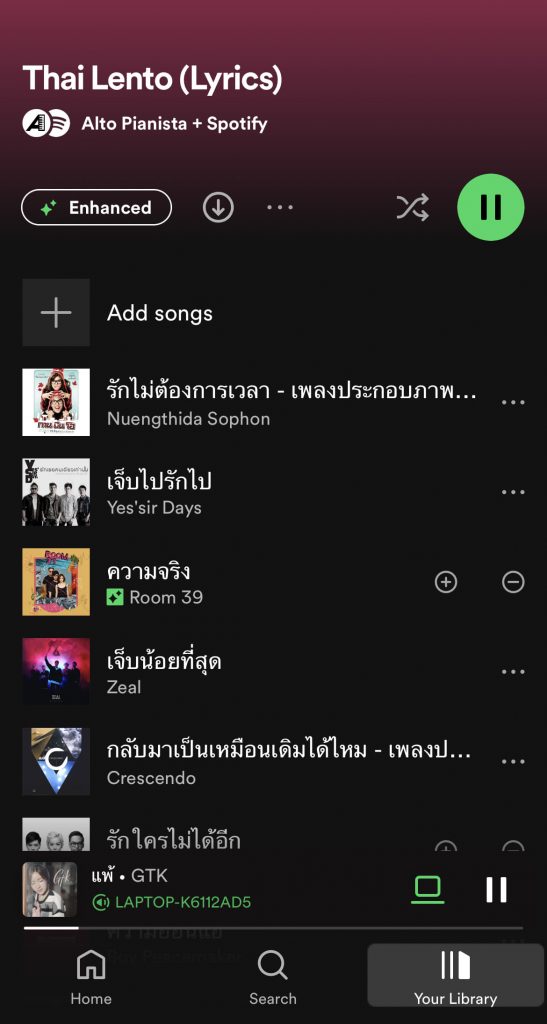


Ultimate Guide to Thai Reading
This is the BananaThai’s course I chose to restart my Thai learning journey. A good part of the content covered what I had already learned and practiced at the end of 2020 with the book Read Thai in 10 Days. The online course format, however, made a big difference for me. It was way more engaging than just reading an e-book. The video and the audio added a lot. Kru Smuk also makes the whole experience very fun and lively. If you watched any of her YouTube videos, you will know what I’m talking about!
Ultimate Guide to Thai Reading covers the fundamentals to learn the Thai script: consonants, live and dead syllables, vowels, tones, the most important rules and exceptions, and the essential marks. The main structure of the course consists of short lessons and exercises to practice. For example:
- Watch a video lesson
- Practice writing skills (either using a tablet/iPad + an e-pen or with pen and paper)
- Practice dividing into syllables, writing equivalent readings in romanized script, and adding tone marks ( — / \ ^ v ) to represent the mid, high, low, falling, and rising tones.
- Fill in a combination chart (magic table)


Usually, it was a combination of the items described above, depending on the moment of the course. One thing I liked especially about BananaThai courses is the content curricula and the instructional design devised by Kru Smuk. Learning the Thai script is arduous, complex, and takes effort. But she broke down the content into manageable parts and reinforced the important topics over and over. That made it easier for me to integrate what I was learning without forgetting the previous content.
Thai Pronunciation Practice
I started the Thai Pronunciation Series course in the first week of study (October 5th). I planned to study the Thai Reading course and the pronunciation course at the same time. Even though the reading course covered the basics of pronunciation, I wanted to go deeper (pronunciation and accent reduction in foreign languages is one of my favorite topics 😊). My teacher, Kru Smuk, confirmed that studying both at the same time was a good learning path for the first few months. So, that’s what I did!
I have many things to improve (creating more space inside my mouth, opening more the jaw, lowering the larynx…), but I would say that improving my awareness of the breath support could go a long way for me. Many times I know that I’m singing more from the throat, but I just forget that there’s another way. These weeks I created opportunities to have new experiences and learned that it is possible to sing differently. Converting these new, more efficient ways into habits takes time and practice. But now at least I know that’s possible!😊
Thai Pronunciation Series (Exercise 2a: Vowel sound drills)
Thai Pronunciation Series (Shadowing Set 5 ให้ [falling])
I appreciate the feedback and suggestions Kru Smuk sent me afterward! ขอบคุณมากครับ! 😊🙏
BananaThai’s pronunciation course was very comprehensive. One of my favorite things was the close-up videos and indications on how to articulate all the vowels. Counting the “compound vowels” (sounds that combine single vowels) there are just way too many sounds to learn! I would say that learning how to pronounce all these vowels is probably the biggest challenge in Thai pronunciation. Another thing that I’ve found quite challenging is the “unvoiced” endings of dead syllables: words that finish in a consonant that is not fully released. For example, dead syllables ending in ก ข ค ฆ -G sound-, บ ป ฟ พ -B sound-, ด จ ต ถ ท ธ -D sound. Producing these ending sounds is already a big challenge, and so much more, recognizing them when you hear them. But I guess it should get better with (good) practice!
On average, while taking this pronunciation course, I divided all my Thai study time into two sets: around half of it (30/40 minutes) for learning how to read, and the other half for pronunciation (20/30 minutes). I also tried to apply what I learned in one course to the other (pronunciation > reading, reading > pronunciation). This way, the reading course helped me understand a little bit of the pronunciation I was practicing, and the other way around.
One of my favorite parts of the course was the shadowing exercises at the end. However, right from the beginning, there was a specific section available -the Pronunciation Gym- to start drilling what we learned in each unit. At the end of the course, there’s a final test. Kru Smuk also encourages the students to send her audio recordings to see how they’re doing. After sending her an audio file, you can expect to get back feedback by e-mail from her. That’s very generous from Kru Smuk!
The Reading Exercises
In the middle of November, after completing the Ultimate Reading Course, I started practicing with the Thai Reading Exercises. These are a series of two short e-books with ten stories each. The stories are very short (usually 7 lines long). For me, that was a plus. My practice dynamic with these stories was the following:
- Read the text on my own
- Translate the story into English line by line, trying to guess the unknown words and phrases
- Read the vocabulary list one item at a time, and complete the empty spaces of my translation
- Read the grammar note of the story
- Complete the exercise of “completing the sentence” at the end of the story
- Watch the video lesson of the story
- Review and improve my translation with Kru Smuk lesson
- Listen to the audio/text version at normal speed once
- Practice shadowing at 0.5x speed
- Practice shadowing again at 1x speed
- Start a new story and repeat!
This was something I designed on my own. Kru Smuk may or may not agree with my method 😄. It might seem like a lot of steps and a lot of time, but it’s not that much. Many days I was able to finish a story in one single one-hour-long session (others not, due to lack of energy, tiredness, or just because the content was over my head 😂).


In December (while I’m writing this article), I made a little change to my practice routine. The first thing I do now is to write all the tones above the Thai script. Then I continue with the other steps. Nowadays, I prefer to start by watching the video lesson and checking if I got all my tones right. Usually, I don’t get all of them right, but most of them are. For example, today (December 9th), after writing the tones for the 5th story of Book 2, I checked with Kru Smuk’s video and noticed that I got 3 tones wrong… out of 105 (in a quick pass, in just a couple of minutes). That’s about 98% right 😀.
Even though I started actively dealing with meaning when I started the Reading Exercises, I was already practicing my reading skills before that (albeit without the meaning dimension). I did that with two Dhamma books in Thai I had at home. I got them in 2018, knowing that. eventually, I would like to learn the language 🙂. So, as early as late October, I was practicing with these books as well. In the last two months of practice, I’ve probably put in a few hours total of painstakingly trying to read phrases from these books out loud.
Once you know the letters that make the Thai script, you need to practice separating what you read into syllables. One of the biggest challenges of the Thai written language is that there are no spaces or separations between words. Theonlyspacesyougetarethosethatseparateonesentencefromthenextone 😄. So, you need to separate the words on your own. But, before separating the words, you need to be able to separate words into syllables. For those of us who are practicing this and don’t even know the meaning of what we are reading, splitting words into syllables turns out to be the only way to make (some) sense of the content. It’s easy: you just need to locate the vowel (before, after, on top or below a consonant), if there’s an ending consonant or not, if there’s a consonant cluster or not, if there are any hidden (unwritten) vowels, a few other things, and you’re good to go 😂. By the way, be ready to come up with plenty of exceptions (words that don’t follow the common rules). Anyway, there’s a method to tackle these “anomalies”: you just memorize each one of them at a time (I use Anki for that!).
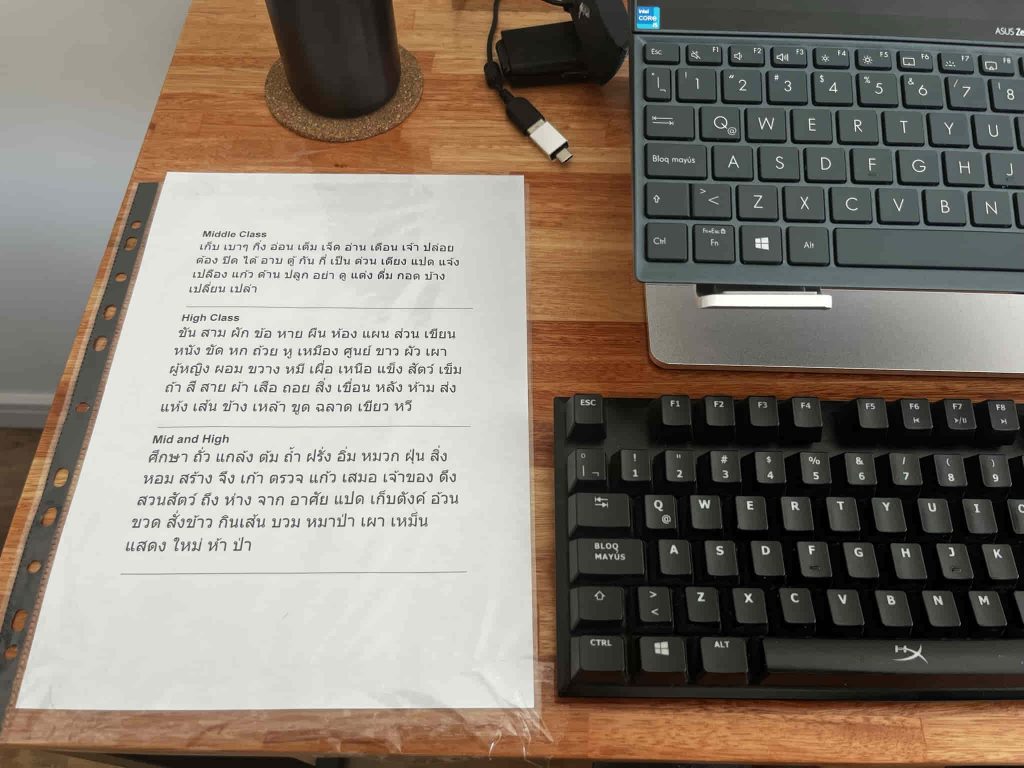

Besides learning the Thai script and separating the content into syllables, you have the tones. There are many rules to learn and to keep in mind while reading, and a handful of tone marks. Eventually, after reading the same word a few times in different contexts, we should be able to remember the tone that goes with it more easily. But in the early stages, reading Thai phrases using the Thai script felt to me like solving a math equation, a puzzle, or a chess tactic problem. At every single syllable, I attempted to read. Hands down, it’s one of the most intellectually demanding activities I’ve ever done in my life. There’s just a ton of information to process at the same time. Reading one line would take me ages. In the beginning, that was plenty! As usual, it gets better with time 🙂.
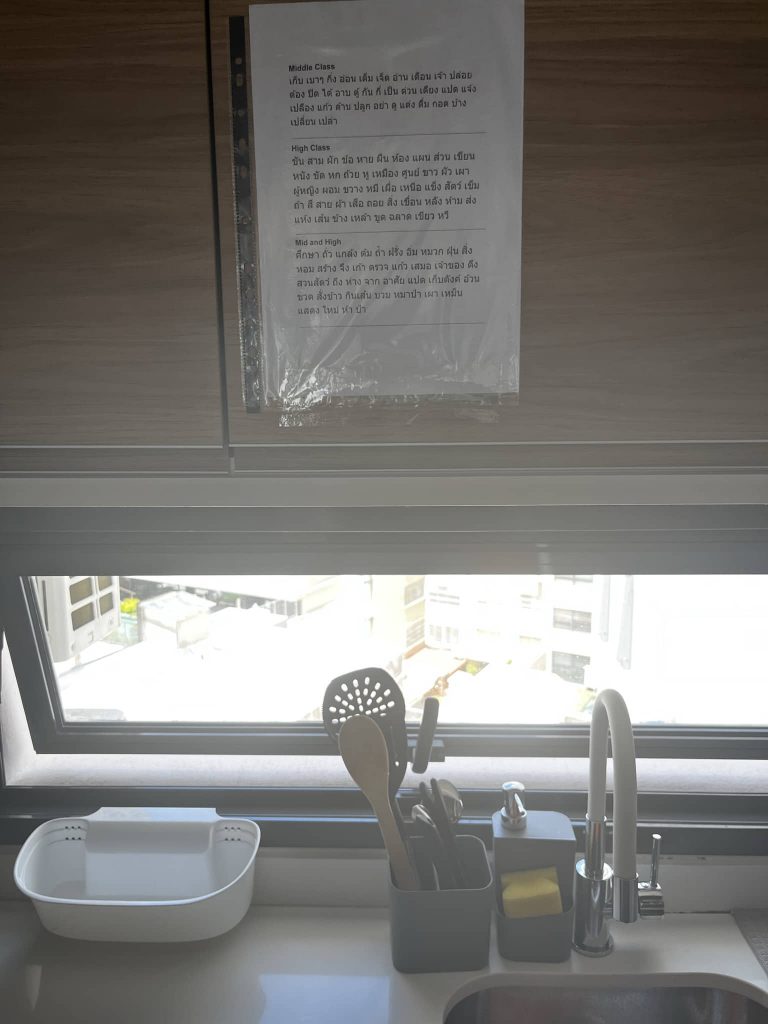
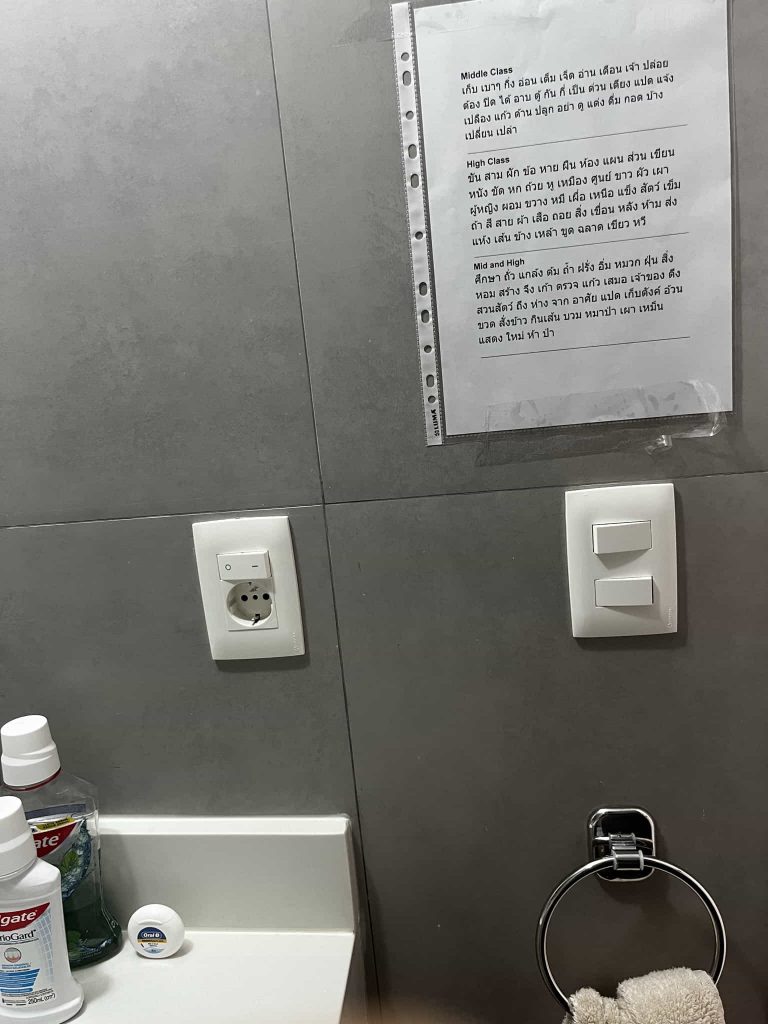
The Thai Reading Exercises allowed me to start reading some phrases automatically and effortlessly. A few examples from the last story (#10) of Book 1:
- ไมเคิล ⇒ Michael
- ชอบ ⇒ to like
- และ ⇒ and
- มาก ⇒ a lot, very
- เขา ⇒ he/she
- ไป ⇒ to go
- ที่ ⇒ at/in a place
- ทำงาน ⇒ to work
- กับ ⇒ with
Sure, these are very easy and frequent words, but to me, it feels like a big accomplishment 😀. All the words above (and some more) are very easy now. I immediately know the meaning at first sight, and I can read them with the correct tone every time (I can also recognize them by ear). The meaning and the tone of these easy words are now connected, they are a single unit. At this point, reading these known words takes zero effort. No need to think of letters, or separate them into syllables, to think of consonant classes, tone marks, tone rules, etc. Nothing. Now I can confirm that improving our reading fluency is just a matter of time (regardless of our target language). As long as we continue learning and practicing well, we will keep on adding more and more words to this easy zone. It gets bigger and bigger.
Anki Practice
I started using Anki in 2012 to learn German. Since then, I’ve also used it to practice Grammar and pronunciation. It helped me increase my vocabulary in Italian, Portuguese, and English. During my first Thai learning attempt, I crafted 168 Anki cards from the book Read Thai in 10 Days and practiced daily with that deck. I put in 2 hours a day for 2/3 weeks to complete that book and create all my Anki cards (including audio). At the end of that period, I was able to recognize almost all the letters (except the less frequent and strange ones, which I would keep confusing) and break words into syllables quite well. Reading the tones was still quite challenging and I wasn’t able to do it decently during the first three months of study (my first attempt).
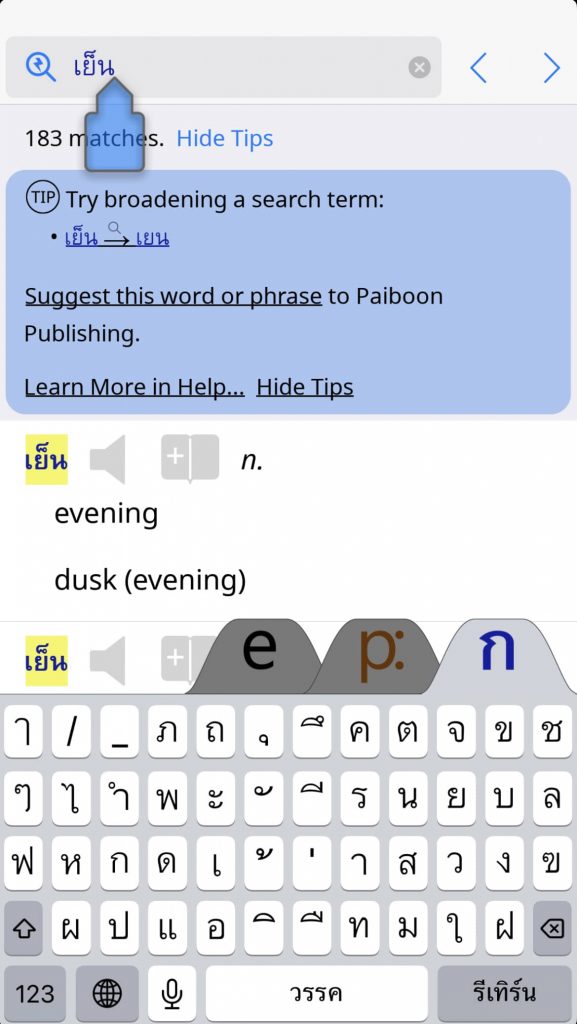

Before starting my second attempt in October 2022 I knew that Anki would be a vital piece to learn, practice, and remember the building blocks of the Thai script. It was obvious to me that I would find it very useful as a beginner, intermediate, and advanced learner. I thought, the sooner I start using it, the better. The first step was converting the Quizlet flashcards offered by Kru Smuk to her students, into Anki’s format (thanks Kru Smuk for your permission to convert those files! 🙂). I ended up creating a few additional cards as well, and I ordered all of them in several mini-decks:
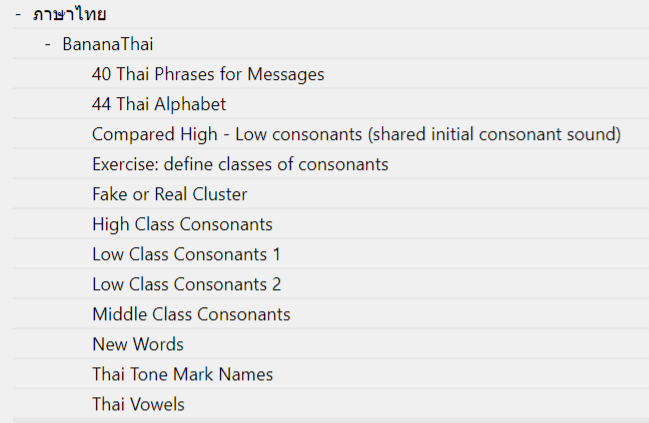
At this point, my BananaThai Anki deck has 239 cards. If you’re curious and want to get a little more info on how I used this deck during the first two months of my studies, here’s a PDF file with my Anki stats for October-November 2022:
anki-stats-2022-12-09@11-48-30Keep in mind that I had already studied the script two months ago. At the moment of resuming my studies last October, I still remembered quite many letters (the most common ones, such as ลบปยนรงวสามทอกคดตไใจข and many of the vowels that go over and under the consonants). But, there were many things I had to learn from scratch. Figuring out how to read the tones proved to be one of the biggest challenges. I don’t mean producing the correct sound for each tone, but knowing when to use the proper tone. In the early stages, that tends to be an exhausting mental exercise (consonant type, ending, vowel length, marks, etc).
What’s Next
In December I intend to continue working with the Thai Reading Exercises. After finishing the second book of BananaThai I will continue practicing with other similar easy readings for the rest of December. In January I will start BananaThai’s Intensive Thai Course and after completing that, the Thai Listening Exercises. Then I would have finished all A1 and A2 resources provided by BananaThai (at the moment I’m writing this, December 2022). For intermediate students (B1), BananaThai offers a Thai group course (Intermediate Thai Fridays) with live lessons and recordings of past classes. In 2022 they also started offering private individual lessons. I think that, after completing the beginner’s resources, I will probably continue with either individual or group lessons. In the last 3 years, I’ve certainly enjoyed that mix of learning on my own and taking lessons. For many students, starting on their own during the first 3-6 months and taking lessons after that period seems to work pretty well.
Conclusion
In March 2021, after learning Thai for almost 3 months without much success, I asked myself: “Should I continue learning Thai after completing the 90 days (my initial goal)? Why should I do it? Why should I not do it?”. It might sound silly, but one of the strongest reasons I had to continue learning the language after the first 90 days was because I had started. I didn’t want to break the streak. I didn’t want to be in the position to say to others in the future (if I resumed my studies later): “I’ve been learning Thai for X time. Oh, and I also studied it for three months between December 2020 and March 2021”. Somehow, I felt like others would count all the time that passed between March 2021 and the moment I would resume my studies as time used to learn Thai. I mean, they would think that time went by and I still didn’t make much progress. Wouldn’t be more impressive to tell them: “Hey, look all I’ve accomplished in just 3 months (or 6 months or 1 one year)!”?
If I thought about why shouldn’t continue with my studies in March 2021, the main argument was I felt that was not the right moment. I just didn’t want to. I was discouraged by my lack of progress after three months of diligent (although ineffective) study. And I wanted to revive my German, bring it back to life again. I didn’t feel like actively studying two languages at the same time. That is why, in the end, I decided to put my Thai studies on hold. Regardless of what others could think of me and despite I don’t like giving up on new projects I start. In hindsight, I think it was the right choice. I prefer to do the things I want to do at the time I want to do them. Not because other people might think or say it’s good for me. Not because I feel obliged to do it. I’m in charge, and I get to choose the moment, the resources, the methods, and the people I invite to be part of my learning experiences.
You can choose to exert this power as well. If you’re learning a language for fun, for your own personal growth and curiosity, you are free to decide how you’re gonna do it. Pick your resources and learning methods, and give them a fair chance. Practice diligently and examine yourself throughout the process. See how you’re feeling and how you’re doing while using these resources. If the weeks pass by and you feel you’re not making significant progress, consider talking about that with an experienced language teacher or a fellow language learner you trust.
Language Learning Coaching
If you’re learning a foreign language (either at the initial, intermediate or advanced stage) and want to get better at it, I could help you reach your learning goals 🙂.
I offer language learning coaching to ambitious and motivated students who want to increase their language skills more effectively and in less time.
I can help you:
- Design a learning plan for your target language, considering your language learning background, skills, and previous experiences
- Develop sustainable learning habits (memorization, daily reading, etc.) to increase your vocabulary, grammar, and general knowledge of your target language
- Choose learning resources for you (digital and/or analogic), so that you will look forward to your practice sessions
- Choose compelling content media in the right difficulty level to supplement your language learning (audio, text, and video) and enjoy the journey
- Get good pronunciation and reduce your foreign accent in your target language
- Keep you accountable with daily and weekly check-ins to help you make progress toward your goals
- Set meaningful language learning goals that will keep you motivated to practice and engage with your target language
If any of that sounds interesting to you, I invite you to get in contact for a free assessment call. I look forward to working with you! 😃🤓

